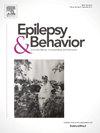Long-term seizure reduction in generalized epilepsy after anterior nucleus of the thalamus stimulation
IF 2.3
3区 医学
Q2 BEHAVIORAL SCIENCES
引用次数: 0
Abstract
Introduction
In 2018 the FDA approved the use of anterior nucleus of the thalamus (ANT) deep brain stimulation (DBS) for focal epilepsy in response to the results of the Stimulation of the Anterior Nucleus of Thalamus for Epilepsy (SANTÉ) double-blind randomized controlled trial. While generalized epilepsy (GE) was never assessed in this trial, subsequent follow up clarified that focal to bilateral tonic-clonic seizures were reduced in these subjects. In rare cases ANT DBS has nonetheless been pursued for patients with GE.
Methods
We report a 27-year-old male with idiopathic GE who was successfully treated with ANT DBS. Prior to DBS, the patient typically had three or four generalized tonic-clonic seizures (GTCS) per week, amongst other seizures, and was refractory to both medication and vagal nerve stimulation (VNS). We also systematically reviewed the literature to understand the extent to which ANT DBS has been used in GE, under what circumstances, and with what results.
Results
Five years since the introduction of ANT DBS, the patient has remained free of GTCS. Over this time, other seizures were also markedly reduced. For the systematic review, a comprehensive literature search using PubMed, Cochrane, and Google Scholar identified 23 GE patients treated with ANT DBS across 13 publications. 13 patients had patient-specific seizure outcomes reported. Clinical findings, seizure characteristics, and outcomes were summarized, demonstrating that ANT DBS surgery typically occurred after failed VNS and was usually effective, including 3 patients who became free of GTCS.
Conclusion
This anecdotal evidence of effectiveness suggests that some GE networks can be modulated by high-frequency stimulation at the ANT node. When established therapies have failed, ANT DBS is a therapeutic option, but the treatment requires further structured research in treating GE.
刺激丘脑前核可长期减少全身性癫痫的发作
本文章由计算机程序翻译,如有差异,请以英文原文为准。
求助全文
约1分钟内获得全文
求助全文
来源期刊

Epilepsy & Behavior
医学-行为科学
CiteScore
5.40
自引率
15.40%
发文量
385
审稿时长
43 days
期刊介绍:
Epilepsy & Behavior is the fastest-growing international journal uniquely devoted to the rapid dissemination of the most current information available on the behavioral aspects of seizures and epilepsy.
Epilepsy & Behavior presents original peer-reviewed articles based on laboratory and clinical research. Topics are drawn from a variety of fields, including clinical neurology, neurosurgery, neuropsychiatry, neuropsychology, neurophysiology, neuropharmacology, and neuroimaging.
From September 2012 Epilepsy & Behavior stopped accepting Case Reports for publication in the journal. From this date authors who submit to Epilepsy & Behavior will be offered a transfer or asked to resubmit their Case Reports to its new sister journal, Epilepsy & Behavior Case Reports.
 求助内容:
求助内容: 应助结果提醒方式:
应助结果提醒方式:


